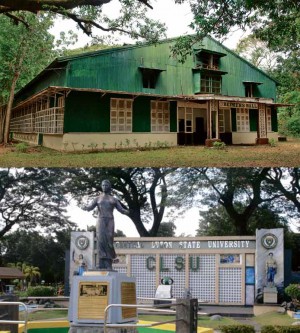
THE REIMER’S Hall inside the Central Luzon State University campus ran the first “talking movies” in Nueva Ecija province and also served as a social hall and a bowling alley. Lower photo shows the main gate of the CLSU, a familiar landmark in the Science City of Muñoz.
PHOTOS BY ANSELMO ROQUE
Science City of Muñoz, NUEVA ECIJA—A quick survey of buildings and other structures at Central Luzon State University (CLSU) in the Science City of Muñoz in Nueva Ecija province will show a modern campus, far from its forerunners, Central Luzon Agricultural School (CLAS), established in 1907, and Central Luzon Agricultural College (CLAC), which was inaugurated in 1952.
Despite this modern façade, landmarks that remind students and visitors of the history behind the country’s first government agricultural school are preserved on its 658-hectare campus. These include Reimer’s Hall, a century-old tree standing on a road, a water reservoir and the school gate featuring a carabao (water buffalo) and a farmer with his plow.
Reimer’s Hall, built during the time of superintendent William Wade Head (1935-1936), was designed to show talking films, then a first in the province.
Made of wood, steel frame and concrete, with a galvanized iron roof, the building was later fitted with acoustics for cinema functions and bowling alleys. It was named Concordia Hall during the time of superintendent Christian Reimer and later renamed Reimer’s Hall.
Equipped with a big stage, the 500-seat hall had been used to stage plays produced by students. In 1939, the school’s first Filipino superintendent, Emeterio Asinas, improved the structure so it can hold functions and social affairs.
The most significant affair held there was the inauguration of CLAC on Jan. 6, 1952. Then President Elpidio Quirino and his defense secretary, Ramon Magsaysay, graced the event. Among the other prominent guests were senators, congressmen, Cabinet members, diplomats, school officials and representatives of the country’s top universities and colleges.
Magsaysay would have returned to Reimer’s Hall on April 5, 1955, as Philippine president during the golden jubilee and graduation programs, but he died in a plane crash on March 17, 1955. He would have been conferred the honorary degree of doctor of agricultural education,
CLAC continued with the program. Two empty chairs, draped in black, and a speaker’s stand decorated with academic regalia, diploma and citations for Magsaysay were set up on the stage to remember the late president.
A modern auditorium was later built beside Reimer’s Hall during the time of then CLSU president Amado Campos, who changed the complexion of the campus with his more than P45-million infrastructure build-up during his term from 1972 to 1986.
Dr. Ruben Sevilleja, incumbent CLSU president, said the school rehabilitated Reimer’s Hall to preserve it for posterity.
Unique landmark
Another unique landmark is a century-old “dungon” tree growing on a road.
In March 1980, the Tree Preservation Foundation of the Philippines (TPFP) placed a marker in front of the tree, which reads: “Here stands a physical obstruction and a road hazard. Nevertheless, [officials] of CLSU very thoughtfully spared it from being cut down in order to leave it as a loving souvenir of the original vegetation here, also a living, if mute, witness to the progress of this great institution.”
Equally sharing attention as a campus landmark is the 80-foot high water reservoir, which is still being used to supply potable water.
Also preserved was the adornment at the main gate, showing a farmer with his carabao and plow.
School officials and students readily consider CLSU the biggest landmark in Muñoz. In the early 1900s, CLSU made a name by pioneering scientific farming, adopting the half-day academic work and half-day practicum, and promoting citizenship training.
Up to the time it became a university in 1964, the student government ran the affairs of what was then known as “Little Republic.” Its governance was patterned after the setup of the national government and the yearly elections were a much anticipated event.
Agricultural tourism
Tourists have been coming to CLSU, which has been declared agricultural tourism site for Luzon by the Department of Tourism.
The Commission on Higher Education (CHEd), in a 1997 article in its newsletter, summed up why it was worthwhile to see this educational institution: “CLSU is indeed an educational Camelot, a model and inspiration for all educational institutions in the country. It not only graduates highly trained alumni, it makes research and provides extension services around the country.
“But more than its productivity and efficiency, it is the ambiance and the brotherhood that reign on the campus that would remind us of the famous phrase: Let it not be forgotten that there is still a place called educational Camelot located right in Central Luzon, near [Mt.] Arayat.”